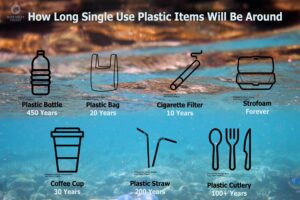 The main reason why there’s so much plastic in the oceans is because of the way our society currently functions.
The main reason why there’s so much plastic in the oceans is because of the way our society currently functions.
People produce more plastic than before. They create trash because they buy things wrapped in plastic, and throw them away. Some people don’t care about recycling, so they just throw away the package and it doesn’t get recycled.
According to the EPA, the ocean is also one of the biggest places where plastic can get thrown away. There are thousands of plastic bags and bottles floating around in the ocean, because people do not use enough dumpster rental near me to discard all their junk effectively.
Sources Of Plastic And How They Get Into The Ocean
Though plastic is used extensively as packaging material, disposable cutlery, cups and even toys for kids, we generate about a million metric tons of plastic waste every single year.
Plastic is a man-made material which contains chemical additives and is derived from petroleum and natural gas. According to a recent study, the concentration of plastic in the world’s oceans will outnumber the fish itself within just a few decades. The cause of the worst plastic pollution is lack of awareness, improper education and lack of leadership.
9.1 billion tons of plastics that have been produced, only 9% have been recycled. The rest end up in landfills via dumpster rental or the oceans. And of course the ocean litter ends up in the stomachs of marine animals and birds.
Even if the ocean litter was stopped at the shoreline, it would still be an immense problem, since plastics are slow to break down. In fact, they never fully break down. Over time, they slowly fragment into tiny particles which often get mistaken for food by birds and fish.
How Does Plastic End Up In The Ocean And What Can Be Done About It
It is widely agreed that about 80% of plastic comes from land-based sources. Plastic litter in the ocean from shipping and fishing accounts for the remaining 20 percent. Taking this broad differentiation a step further, the sources of oceans plastic can become a little more difficult to determine.
From Land To Sea
It could be confusing to consider that even litter from cities and inland towns contributes to the growth of ocean plastic. The fact that the sea was downhill from all the water sources is critical in this situation because rubbish that enters waterways or rivers can very readily make its way to the ocean.
Take, for example, a single plastic bottle in the city. The bottle is placed in a garbage can on the street, where it is blown into streets and then into the storm drain, where it can eventually enter the river and be carried out to sea.
There Are Numerous Sources Of Land-Based Litter:
- Litter from garbage bins & storm water drains that is found on the ground.
- There are two main ways that trash ends up on the coast: through being dumped on the beach or by poor waste management practises.
- Litter can readily be blown into river from overflowing bins.
- Leakage from waste management systems, e.g. landfill sites, especially those near rivers or the coastline.
- Disposal of human waste, such as wet wipes and other sanitary goods, directly into the water supply.
The Effects Of Ocean Plastic Pollution
Ocean plastic pollution is a very serious problem, as it is killing a large number of sea animals. For example, it is killing whales and other marine mammals when they swallow it, often getting stuck in the animal’s throat or gut.
It is also clogging the ocean and killing coral reefs, which can be found both in shallow waters and in deep oceans. It is also killing fish and other aquatic life because the plastic can get caught in their mouths or can poison them by getting into the water, or even by blocking their gills.
Another big problem could be that trash that is dumped on land could end up in the ocean, because of powerful winds that pick up everything.
Finally, ocean plastic pollution could even be damaging the health of humans. The plastic toxins can be absorbed by the fish and then by the humans who eat the fish. As a result, the consequences of plastic pollution are serious and widespread, despite the fact that the plastic waste in the ocean is difficult to notice since it is only a small part of the ocean itself.
The Solutions To Ocean Plastic Pollution
As far as waste management is concernet, there are three main things that can be done :
1. Be careful with your choices and refuse single-use plastic items. The majority of the ocean plastic pollution comes from land. If you need something packaged, you should choose options that are sustainable.
2. Join beach clean-ups. Beach clean-ups are a fun way to take action and reduce ocean plastic pollution by putting all the junk in a dumpster rental. Plastic pollution is a much more serious problem than many people think. It is harmful to the environment, wildlife and sea animals, who cannot digest it.
3. Buy reusable bags for the grocery store. A lot of plastic bag pollution comes from the grocery stores. Incidentally, reusable bags are also a lot better for the environment.